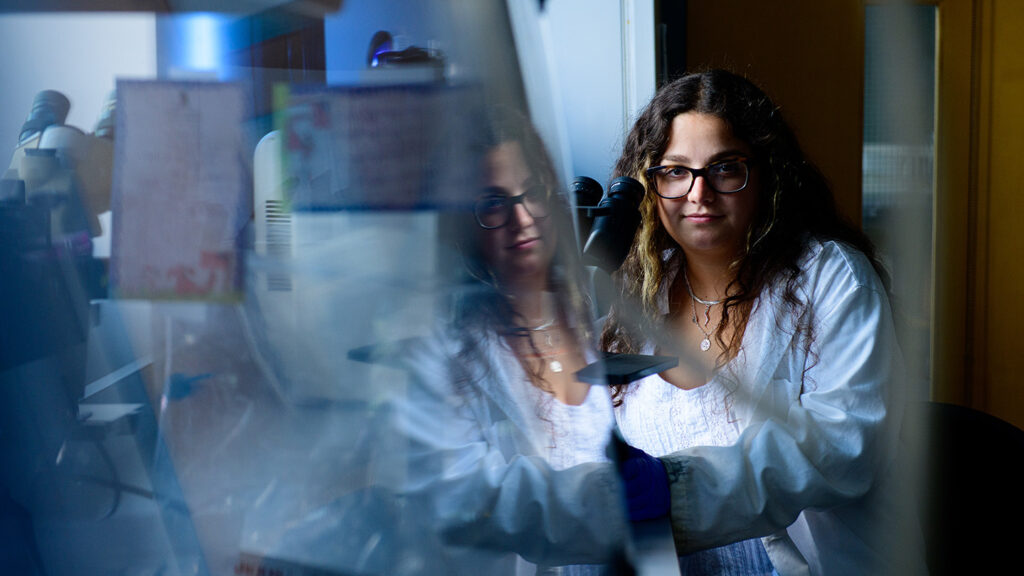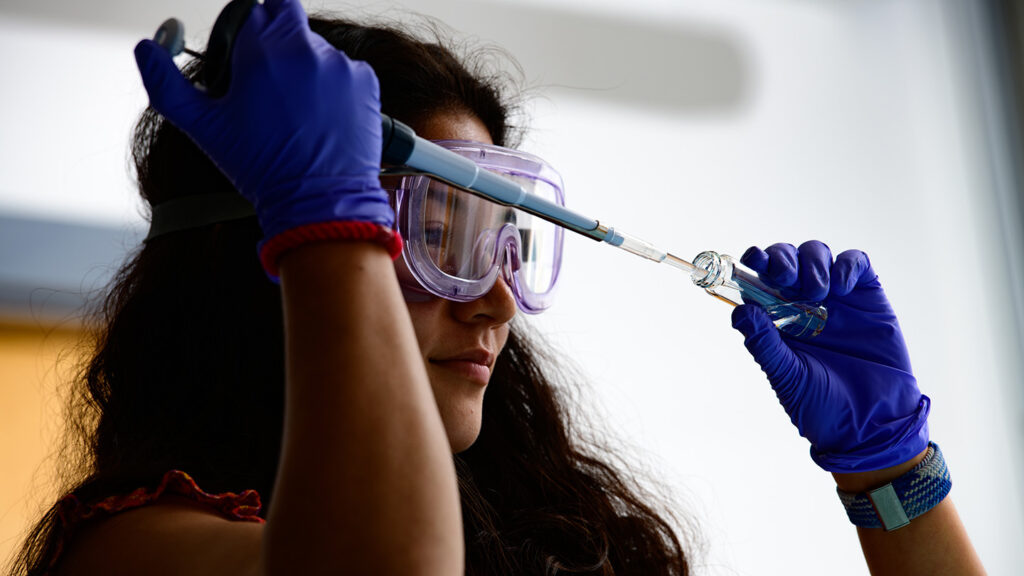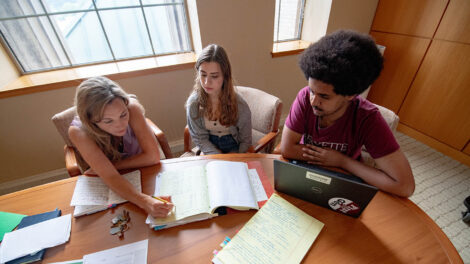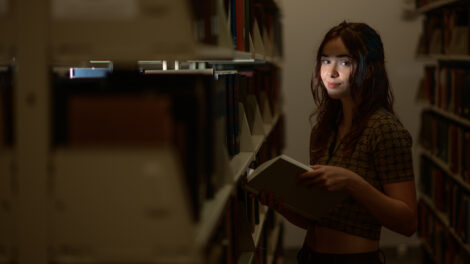Studying nanoplastics and antibiotics in aqueous environments
Each summer, Lafayette College students have the opportunity to participate in academically meaningful experiences outside the classroom. Students selected as EXCEL Scholars engage in collaborative research projects with Lafayette faculty, enhancing their academic skills as well as developing other skills that will be useful in post-graduate education and careers. This summer, we are highlighting several scholars who are working on hands-on, collaborative research projects with faculty and other students.

Abrienne Biondo ’24 works with cells that are used for exposure experiments.
Student researchers: anna difelice ’24, chemistry, abrienne biondo ’24, biochemistry, anna silver ’25, chemistry
adviser: arielle mensch, assistant professor of chemistry
How did this research get started?
Prof. Mensch: “Both my graduate school work and my postdoc were part of something called the Center for Sustainable Nanotechnology. This is an interdisciplinary group across the Midwest and on both sides of the coast, and they’re actually funding Abrienne’s research for the summer. That center was more focused on emerging nanotechnologies, like lithium ion battery materials. We call them ‘next generation materials.’ With emerging materials, we don’t really know what’s going to happen when they get into the environment. With nanoplastics and microplastics, we know there’s a ton of those in the environment already, but we don’t know exactly what they’re doing to environmental systems. So, our lab looks at different model systems and studies how nano- and microplastics might actually transport other things that humans have put into the environment—like antibiotics or other types of organic pollutants that are present.”
In the lab, are you looking at those plastics or pollutants?
Prof. Mensch: “Both. For plastics right now we’re using polystyrene beads as one example. While that might not be the exact thing you would find floating in the ocean, it serves as a representative model. For pollutants, we’re using a suite of different antibiotics. For both plastics and pollutants, we think about the different properties of the materials (e.g., size, charge, chemical properties) and try to understand how the different properties may impact their interactions and their behavior in different environments.”

Anna DeFelice ’24 works with quartz crystal microbalance to measure how much nanoplastic would deposit onto a riverbed.
What are you working on, and what are you getting out of working in this lab?
Silver: “When I first started working in the lab, it was a little nerve-wracking. I honestly felt at times like I didn’t know what was being discussed. I knew, though, that this is an environment where you are encouraged to ask questions or ask for help from your peers. So, I’ve felt really supported. And working in the lab is fun, but I also feel like I’m learning, and it’s not a place where there’s like heavy consequences. We’re able to learn at a certain pace, or if there’s a mistake or something breaks, it’s part of the process.”
DiFelice: “Working in a lab has definitely helped me figure out what I’m interested in and what I’m not. I realized I’m not as interested in the engineering side of things, but I am interested in the science behind things and why something happens, rather than the fact that it does. I like coming in every day and having a pattern over the summer, because it helps me feel more prepared for my career and what working in the real world will be like.
“I use an instrument called a QCM, which is a quartz crystal microbalance. With it, we measure how much nanoplastic would deposit onto a riverbed. So, if we were to put plastic in the water stream and then combine it with antibiotics, what would happen? Will it sink to the bottom, or will it keep floating in the water column and then eventually affect fish?”
Biondo: “I work on the cell side of things, so it’s very different from what [DiFelice and Silver] do. I usually have the cells growing, and then I also have cells that are seeded in plates, which are used for exposure experiments. I’ll think of exposure experiments I want to do with the plastics and the antibiotics, run them by Prof. Mensch, and she’ll approve it. A typical exposure sits overnight and takes about three days.
“Working with the cells, you can see the direct environmental impact of the work that we do, and it’s very interesting to see this can actually be affecting our marine animals. Also, seeing when I get data, and the cells did end up dying, it’s eye-opening, too, because humans do contribute to plastic in the water. It’s interesting to see the real-life application I can get out of it.”
Silver: “I work with dynamic light scattering, and I also run zeta potential [to measure the size and charge of nanoplastics with and without antibiotics]. I take the data and work it into Excel or Google sheets. When the data is done for the day, we’ll talk through our findings.”

Anna Silver ’25 works with dynamic light scattering and runs zeta potential to measure the size and charge of nanoplastics with and without antibiotics.
What role do antibiotics play?
Prof. Mensch: “For the [trout gill] cell studies, one of the things that we’re really interested in is called the Trojan horse effect. It’s this idea that if you have plastic—and say a fish engulfs that plastic—maybe that plastic won’t actually do anything to the fish. But if that plastic is coated in something that’s more harmful, and then the fish takes up that plastic that has this antibiotic, that’s harmful to the fish. Maybe that’s a way in which that micro- or nanoplastic has served as a vector to bring in that more harmful organic compound. That’s the rationale behind thinking about antibiotics and thinking about how they might impact the properties of the plastics.”
What has been everyone’s favorite part of the lab so far?
Biondo: “Originally when I came into the lab, I was a biology major, so I was obviously looking for something bio-related. I am very happy that I got to work on this project, because it’s been super fun. The cell-culturing process is a really good technique that I was excited to learn about. When I think through the research, it’s made me decide to change my major to biochemistry, which I’m in the process of doing now. I really enjoy lab work, which I’ll get a lot of with biochemistry.”
DiFelice: “I definitely think the best part of being in a lab is learning new things and being exposed to new things over the summer, so that you can come back into the fall semester feeling fresh. In the lab, you’re also making new connections and networking, but with the aspect of friendship included—and we all have developed a great friendship with Dr. Mensch, as well.”
Silver: “I wasn’t really sure of a major when I first came here, but I knew I wanted to do research, and I knew I was interested in STEM. But I didn’t really know where I fit in with that. This experience has let me see how the chemistry department supports students. We’ll have our meetings, and there’s a lot of women in the chemistry department. It’s helping me decide what I want to do in the future.”
Prof. Mensch: “Definitely working with the students. We also do a lot of different activities together. We have something called ‘Fun Experiment Fridays,’ and the students also have a TikTok to communicate to non-scientists what they’re working on in the lab.”
hands-on research

Lafayette's EXCEL Scholar Program
Lafayette's EXCEL Scholars program allows students to work closely and collaboratively with faculty on significant research projects that hone critical-thinking and communication skills

